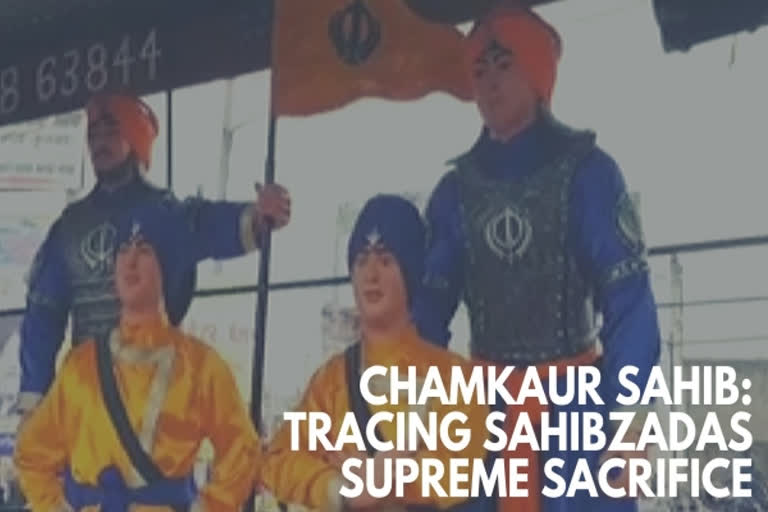Chamkaur Sahib (Punjab): While tracing the footsteps of the 10th Sikh Guru Gobind Singh, his four sons also known as 'Char Sahibzade', who attained martyrdom before reaching adulthood, and his mother Mata Gujri, ETV Bharat arrived at Gurudwara Sri Qatalgarh Sahib in Chamkaur town of Punjab's Rupnagar district.
It is here that “vaade sahibzade” - Ajit Singh, and Jujhar Singh, aged 18 and 14, the older sons of Guru Gobind Singh laid down their lives while fighting the battle at Chamkaur Sahib. A battle that was fought between the 'Khalsa', led by Guru Gobind Singh, against the Mughal army led by Wazir Khan, and Ajmer Chand's league of Rajput Hill Chieftains.
Members of the Sikh community, among other believers, annually gather in large numbers at the Gurudwara around this time of the year to acknowledge the supreme sacrifice made by the two Sahibzade, and to pay their respect.
"We are here from Bhai Nand Lal Public School in Anandpur Sahib. We come here every year to pay our respect," a young student told ETV Bharat.
History behind the supreme sacrifice
After leaving Anandpur Sahib and the Anandgarh Fort, the Tenth Guru, along with his family and an army of followers reached the banks of river Sarsa on the intervening night of December 21, 1704, Guru Gobind Singh's family got separated.
While the two elder sons and the band of Sikh warriors remained with the Guru, his mother and two younger sons were left alone.
Later in the day, Guru Gobind, along with Ajit, Jujhar, his 'Panj piaras' and 40 Singhs camped in an open space in Chamkaur.
On the same evening they took control of Kachi Garhi - a Mud fort on a small hill - owned by two brothers Chaudhari Roop Chand and Jagat Singh.
During the course of the day, a Mughal messenger visited the fort to negotiate with the Sikhs. The offer was, however, declined by the Guru and war was declared from both the sides.
The battle of Chamkaur, which lasted for three days, culminated in the martyrdom of both Ajit Singh and Jujhar Singh, apart from several other Sikh men and Mughal soldiers.
But, the young duo attained martyrdom after putting up a fierce fight with the overwhelmingly well-equipped and large Mughal force.
Also read: Gurdwara Parivar Vichora: The spot of battle, betrayal and separation
In a bid to commemorate the sacrifice made by the two Sahibzadas and several other Sikh soldiers during the battle of Chamkaur, a Gurudwara named 'Gurudwara Garhi Sahib' was erected at the battle site and another Gurudwara - Gurudwara Qatalgarh Sahib - was built at the site of cremation of Guru Gobind's two sons.



